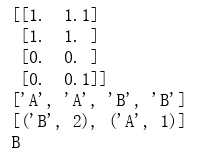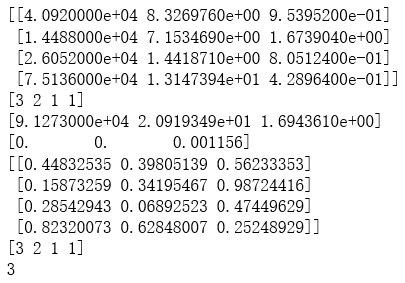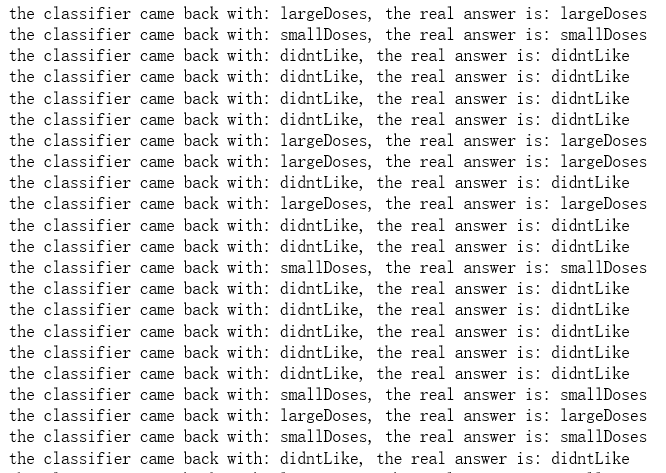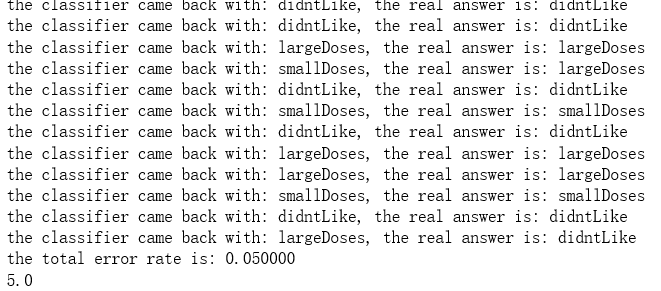吴裕雄 python 机器学习-KNN算法(1)
import numpy as np
import operator as op
from os import listdir def classify0(inX, dataSet, labels, k):
dataSetSize = dataSet.shape[0]
diffMat = np.tile(inX, (dataSetSize,1)) - dataSet
sqDiffMat = diffMat**2
sqDistances = sqDiffMat.sum(axis=1)
distances = sqDistances**0.5
sortedDistIndicies = distances.argsort()
classCount={}
for i in range(k):
voteIlabel = labels[sortedDistIndicies[i]]
classCount[voteIlabel] = classCount.get(voteIlabel,0) + 1
sortedClassCount = sorted(classCount.items(), key=op.itemgetter(1), reverse=True)
return sortedClassCount[0][0] def createDataSet():
group = np.array([[1.0,1.1],[1.0,1.0],[0,0],[0,0.1]])
labels = ['A','A','B','B']
return group, labels data,labels = createDataSet()
print(data)
print(labels) test = np.array([[0,0.5]])
result = classify0(test,data,labels,3)
print(result)

import numpy as np
import operator as op
from os import listdir def classify0(inX, dataSet, labels, k):
dataSetSize = dataSet.shape[0]
diffMat = np.tile(inX, (dataSetSize,1)) - dataSet
sqDiffMat = diffMat**2
sqDistances = sqDiffMat.sum(axis=1)
distances = sqDistances**0.5
sortedDistIndicies = distances.argsort()
classCount={}
for i in range(k):
voteIlabel = labels[sortedDistIndicies[i]]
classCount[voteIlabel] = classCount.get(voteIlabel,0) + 1
sortedClassCount = sorted(classCount.items(), key=op.itemgetter(1), reverse=True)
return sortedClassCount[0][0] def file2matrix(filename):
fr = open(filename)
returnMat = []
classLabelVector = [] #prepare labels return
for line in fr.readlines():
line = line.strip()
listFromLine = line.split('\t')
returnMat.append([float(listFromLine[0]),float(listFromLine[1]),float(listFromLine[2])])
classLabelVector.append(int(listFromLine[-1]))
return np.array(returnMat),np.array(classLabelVector) trainData,trainLabel = file2matrix("D:\\LearningResource\\machinelearninginaction\\Ch02\\datingTestSet2.txt")
print(trainData[0:4])
print(trainLabel[0:4]) def autoNorm(dataSet):
minVals = dataSet.min(0)
maxVals = dataSet.max(0)
ranges = maxVals - minVals
normDataSet = np.zeros(np.shape(dataSet))
m = dataSet.shape[0]
normDataSet = dataSet - np.tile(minVals, (m,1))
normDataSet = normDataSet/np.tile(ranges, (m,1)) #element wise divide
return normDataSet, ranges, minVals normDataSet, ranges, minVals = autoNorm(trainData)
print(ranges)
print(minVals)
print(normDataSet[0:4])
print(trainLabel[0:4]) testData = np.array([[0.5,0.3,0.5]])
result = classify0(testData, normDataSet, trainLabel, 5)
print(result)

import numpy as np
import operator as op
from os import listdir def classify0(inX, dataSet, labels, k):
dataSetSize = dataSet.shape[0]
diffMat = np.tile(inX, (dataSetSize,1)) - dataSet
sqDiffMat = diffMat**2
sqDistances = sqDiffMat.sum(axis=1)
distances = sqDistances**0.5
sortedDistIndicies = distances.argsort()
classCount={}
for i in range(k):
voteIlabel = labels[sortedDistIndicies[i]]
classCount[voteIlabel] = classCount.get(voteIlabel,0) + 1
sortedClassCount = sorted(classCount.items(), key=op.itemgetter(1), reverse=True)
return sortedClassCount[0][0] def file2matrix(filename):
fr = open(filename)
returnMat = []
classLabelVector = [] #prepare labels return
for line in fr.readlines():
line = line.strip()
listFromLine = line.split('\t')
returnMat.append([float(listFromLine[0]),float(listFromLine[1]),float(listFromLine[2])])
classLabelVector.append(listFromLine[-1])
return np.array(returnMat),np.array(classLabelVector) def autoNorm(dataSet):
minVals = dataSet.min(0)
maxVals = dataSet.max(0)
ranges = maxVals - minVals
normDataSet = np.zeros(np.shape(dataSet))
m = dataSet.shape[0]
normDataSet = dataSet - np.tile(minVals, (m,1))
normDataSet = normDataSet/np.tile(ranges, (m,1)) #element wise divide
return normDataSet, ranges, minVals normDataSet, ranges, minVals = autoNorm(trainData) def datingClassTest():
hoRatio = 0.10 #hold out 10%
datingDataMat,datingLabels = file2matrix("D:\\LearningResource\\machinelearninginaction\\Ch02\\datingTestSet.txt")
normMat, ranges, minVals = autoNorm(datingDataMat)
m = normMat.shape[0]
numTestVecs = int(m*hoRatio)
errorCount = 0.0
for i in range(numTestVecs):
classifierResult = classify0(normMat[i,:],normMat[numTestVecs:m,:],datingLabels[numTestVecs:m],3)
print(('the classifier came back with: %s, the real answer is: %s') % (classifierResult, datingLabels[i]))
if (classifierResult != datingLabels[i]):
errorCount += 1.0
print(('the total error rate is: %f') % (errorCount/float(numTestVecs)))
print(errorCount) datingClassTest()
import numpy as np
import operator as op
from os import listdir def classify0(inX, dataSet, labels, k):
dataSetSize = dataSet.shape[0]
diffMat = np.tile(inX, (dataSetSize,1)) - dataSet
sqDiffMat = diffMat**2
sqDistances = sqDiffMat.sum(axis=1)
distances = sqDistances**0.5
sortedDistIndicies = distances.argsort()
classCount={}
for i in range(k):
voteIlabel = labels[sortedDistIndicies[i]]
classCount[voteIlabel] = classCount.get(voteIlabel,0) + 1
sortedClassCount = sorted(classCount.items(), key=op.itemgetter(1), reverse=True)
return sortedClassCount[0][0] def file2matrix(filename):
fr = open(filename)
returnMat = []
classLabelVector = [] #prepare labels return
for line in fr.readlines():
line = line.strip()
listFromLine = line.split('\t')
returnMat.append([float(listFromLine[0]),float(listFromLine[1]),float(listFromLine[2])])
classLabelVector.append(listFromLine[-1])
return np.array(returnMat),np.array(classLabelVector) def autoNorm(dataSet):
minVals = dataSet.min(0)
maxVals = dataSet.max(0)
ranges = maxVals - minVals
normDataSet = np.zeros(np.shape(dataSet))
m = dataSet.shape[0]
normDataSet = dataSet - np.tile(minVals, (m,1))
normDataSet = normDataSet/np.tile(ranges, (m,1)) #element wise divide
return normDataSet, ranges, minVals normDataSet, ranges, minVals = autoNorm(trainData) def datingClassTest():
hoRatio = 0.10 #hold out 10%
datingDataMat,datingLabels = file2matrix("D:\\LearningResource\\machinelearninginaction\\Ch02\\datingTestSet.txt")
normMat, ranges, minVals = autoNorm(datingDataMat)
m = normMat.shape[0]
numTestVecs = int(m*hoRatio)
errorCount = 0.0
for i in range(numTestVecs):
classifierResult = classify0(normMat[i,:],normMat[numTestVecs:m,:],datingLabels[numTestVecs:m],3)
print(('the classifier came back with: %s, the real answer is: %s') % (classifierResult, datingLabels[i]))
if (classifierResult != datingLabels[i]):
errorCount += 1.0
print(('the total error rate is: %f') % (errorCount/float(numTestVecs)))
print(errorCount) datingClassTest()

................................................

import numpy as np
import operator as op
from os import listdir def classify0(inX, dataSet, labels, k):
dataSetSize = dataSet.shape[0]
diffMat = np.tile(inX, (dataSetSize,1)) - dataSet
sqDiffMat = diffMat**2
sqDistances = sqDiffMat.sum(axis=1)
distances = sqDistances**0.5
sortedDistIndicies = distances.argsort()
classCount={}
for i in range(k):
voteIlabel = labels[sortedDistIndicies[i]]
classCount[voteIlabel] = classCount.get(voteIlabel,0) + 1
sortedClassCount = sorted(classCount.items(), key=op.itemgetter(1), reverse=True)
return sortedClassCount[0][0] def file2matrix(filename):
fr = open(filename)
returnMat = []
classLabelVector = [] #prepare labels return
for line in fr.readlines():
line = line.strip()
listFromLine = line.split('\t')
returnMat.append([float(listFromLine[0]),float(listFromLine[1]),float(listFromLine[2])])
classLabelVector.append(int(listFromLine[-1]))
return np.array(returnMat),np.array(classLabelVector) def autoNorm(dataSet):
minVals = dataSet.min(0)
maxVals = dataSet.max(0)
ranges = maxVals - minVals
normDataSet = np.zeros(np.shape(dataSet))
m = dataSet.shape[0]
normDataSet = dataSet - np.tile(minVals, (m,1))
normDataSet = normDataSet/np.tile(ranges, (m,1)) #element wise divide
return normDataSet, ranges, minVals def classifyPerson():
resultList = ["not at all", "in samll doses", "in large doses"]
percentTats = float(input("percentage of time spent playing video game?"))
ffMiles = float(input("frequent flier miles earned per year?"))
iceCream = float(input("liters of ice cream consumed per year?"))
testData = np.array([percentTats,ffMiles,iceCream])
trainData,trainLabel = file2matrix("D:\\LearningResource\\machinelearninginaction\\Ch02\\datingTestSet2.txt")
normDataSet, ranges, minVals = autoNorm(trainData)
result = classify0((testData-minVals)/ranges, normDataSet, trainLabel, 3)
print("You will probably like this person: ",resultList[result-1]) classifyPerson()
import numpy as np
import operator as op
from os import listdir def classify0(inX, dataSet, labels, k):
dataSetSize = dataSet.shape[0]
diffMat = np.tile(inX, (dataSetSize,1)) - dataSet
sqDiffMat = diffMat**2
sqDistances = sqDiffMat.sum(axis=1)
distances = sqDistances**0.5
sortedDistIndicies = distances.argsort()
classCount={}
for i in range(k):
voteIlabel = labels[sortedDistIndicies[i]]
classCount[voteIlabel] = classCount.get(voteIlabel,0) + 1
sortedClassCount = sorted(classCount.items(), key=op.itemgetter(1), reverse=True)
return sortedClassCount[0][0] def file2matrix(filename):
fr = open(filename)
returnMat = []
classLabelVector = [] #prepare labels return
for line in fr.readlines():
line = line.strip()
listFromLine = line.split('\t')
returnMat.append([float(listFromLine[0]),float(listFromLine[1]),float(listFromLine[2])])
classLabelVector.append(int(listFromLine[-1]))
return np.array(returnMat),np.array(classLabelVector) def autoNorm(dataSet):
minVals = dataSet.min(0)
maxVals = dataSet.max(0)
ranges = maxVals - minVals
normDataSet = np.zeros(np.shape(dataSet))
m = dataSet.shape[0]
normDataSet = dataSet - np.tile(minVals, (m,1))
normDataSet = normDataSet/np.tile(ranges, (m,1)) #element wise divide
return normDataSet, ranges, minVals def classifyPerson():
resultList = ["not at all", "in samll doses", "in large doses"]
percentTats = float(input("percentage of time spent playing video game?"))
ffMiles = float(input("frequent flier miles earned per year?"))
iceCream = float(input("liters of ice cream consumed per year?"))
testData = np.array([percentTats,ffMiles,iceCream])
trainData,trainLabel = file2matrix("D:\\LearningResource\\machinelearninginaction\\Ch02\\datingTestSet2.txt")
normDataSet, ranges, minVals = autoNorm(trainData)
result = classify0((testData-minVals)/ranges, normDataSet, trainLabel, 3)
print("You will probably like this person: ",resultList[result-1]) classifyPerson()

import numpy as np
import operator as op
from os import listdir def classify0(inX, dataSet, labels, k):
dataSetSize = dataSet.shape[0]
diffMat = np.tile(inX, (dataSetSize,1)) - dataSet
sqDiffMat = diffMat**2
sqDistances = sqDiffMat.sum(axis=1)
distances = sqDistances**0.5
sortedDistIndicies = distances.argsort()
classCount={}
for i in range(k):
voteIlabel = labels[sortedDistIndicies[i]]
classCount[voteIlabel] = classCount.get(voteIlabel,0) + 1
sortedClassCount = sorted(classCount.items(), key=op.itemgetter(1), reverse=True)
return sortedClassCount[0][0] def img2vector(filename):
returnVect = []
fr = open(filename)
for i in range(32):
lineStr = fr.readline()
for j in range(32):
returnVect.append(int(lineStr[j]))
return np.array([returnVect]) def handwritingClassTest():
hwLabels = []
trainingFileList = listdir('D:\\LearningResource\\machinelearninginaction\\Ch02\\trainingDigits') #load the training set
m = len(trainingFileList)
trainingMat = np.zeros((m,1024))
for i in range(m):
fileNameStr = trainingFileList[i]
fileStr = fileNameStr.split('.')[0] #take off .txt
classNumStr = int(fileStr.split('_')[0])
hwLabels.append(classNumStr)
trainingMat[i,:] = img2vector('D:\\LearningResource\\machinelearninginaction\\Ch02\\trainingDigits\\%s' % fileNameStr)
testFileList = listdir('D:\\LearningResource\\machinelearninginaction\\Ch02\\testDigits') #iterate through the test set
mTest = len(testFileList)
errorCount = 0.0
for i in range(mTest):
fileNameStr = testFileList[i]
fileStr = fileNameStr.split('.')[0] #take off .txt
classNumStr = int(fileStr.split('_')[0])
vectorUnderTest = img2vector('D:\\LearningResource\\machinelearninginaction\\Ch02\\testDigits\\%s' % fileNameStr)
classifierResult = classify0(vectorUnderTest, trainingMat, hwLabels, 3)
print("the classifier came back with: %d, the real answer is: %d" % (classifierResult, classNumStr))
if (classifierResult != classNumStr):
errorCount += 1.0
print("\nthe total number of errors is: %d" % errorCount)
print("\nthe total error rate is: %f" % (errorCount/float(mTest))) handwritingClassTest()

.......................................

吴裕雄 python 机器学习-KNN算法(1)的更多相关文章
- 吴裕雄 python 机器学习——KNN回归KNeighborsRegressor模型
import numpy as np import matplotlib.pyplot as plt from sklearn import neighbors, datasets from skle ...
- 吴裕雄 python 机器学习——KNN分类KNeighborsClassifier模型
import numpy as np import matplotlib.pyplot as plt from sklearn import neighbors, datasets from skle ...
- 吴裕雄 python 机器学习-KNN(2)
import matplotlib import numpy as np import matplotlib.pyplot as plt from matplotlib.patches import ...
- 吴裕雄 python 机器学习——半监督学习标准迭代式标记传播算法LabelPropagation模型
import numpy as np import matplotlib.pyplot as plt from sklearn import metrics from sklearn import d ...
- 吴裕雄 python 机器学习——集成学习AdaBoost算法回归模型
import numpy as np import matplotlib.pyplot as plt from sklearn import datasets,ensemble from sklear ...
- 吴裕雄 python 机器学习——集成学习AdaBoost算法分类模型
import numpy as np import matplotlib.pyplot as plt from sklearn import datasets,ensemble from sklear ...
- 吴裕雄 python 机器学习——人工神经网络感知机学习算法的应用
import numpy as np from matplotlib import pyplot as plt from sklearn import neighbors, datasets from ...
- 吴裕雄 python 机器学习——半监督学习LabelSpreading模型
import numpy as np import matplotlib.pyplot as plt from sklearn import metrics from sklearn import d ...
- 吴裕雄 python 机器学习——人工神经网络与原始感知机模型
import numpy as np from matplotlib import pyplot as plt from mpl_toolkits.mplot3d import Axes3D from ...
随机推荐
- 通过Xshell来访问和连接Linux
Xshell初使用:Xshell资源下载 刚刚接触Xshell是在javamail中的telnet收发邮件,然而这个我们并不常用,用的最多的是Xshell进行访问和连接远程主机. 通过Xshell来访 ...
- TextView右上角显示小红点,小红点根据TextView的长度移动,小红点被TextView挤出去不显示的问题;
大概就是图片这个样,这个功能很常见,本来我以为很简单,谁知道真的很简单: 遇到点小问题,记录一下,哈哈: 小红点的Drawable: <?xml version="1.0" ...
- Linux netstat命令查看并发连接数
netstat -n | awk '/^tcp/ {++S[$NF]} END {for(a in S) print a, S[a]}' 解释: 返回结果示例: LAST_ACK 5 (正在等待处理的 ...
- es6(13)--Promise
//Promise { //原始方法 let ajax=function(callback){ console.log('执行') setTimeout(function(){ callback&am ...
- 安全测试6_Web安全工具第二节(代理抓包分析工具)
上节课讲了浏览器及扩展,这节课继续来学习下抓包分析. 首先看下下图,了解下代理工具的原理:代理就相当于收费站一样,任何要通过的车辆必须经过它. 浏览器的代理我们可以通过设置进行手动设置代理,或者通过P ...
- Java并发编程:Java Thread 的 sleep() 和 wait() 的区别
1. start 和 run 方法解释: 1) start: 用start方法来启动线程,真正实现了多线程运行,这时无需等待run方法体代码执行完毕而直接继续执行下面的代码.通过调用Thread类 ...
- uiautomator2.0的配置的两种方法
方法一(使用在线下载的方式导入依赖): 1.首先创建项目工程,创建的项目的android_api版本要与测试的android_api版本一致(24就是24 ,不能26或者17去兼容) 2.然后就是将本 ...
- 20165205 2017-2018-2 《Java程序设计》第七周学习总结
20165205 2017-2018-2 <Java程序设计>第七周学习总结 教材学习内容总结 下载XAMPP并完成配置 完成XAMPP与数据库的连接 学会创建一个数据库 学会用java语 ...
- ORA-01461的解决过程~~
转自:http://blog.itpub.net/7607759/viewspace-521189 近日生产库中的一个过程报出了ora-1461的错误,虽然错误实际处理起来非常简单,但解决过程中与ya ...
- redis下操作Set和Zset
redis操作set 无序集合 元素为string类型 元素具有唯一性,不重复 命令 设置 添加元素 SADD key member [member ...] 获取 返回key集合所有的元素 SME ...
